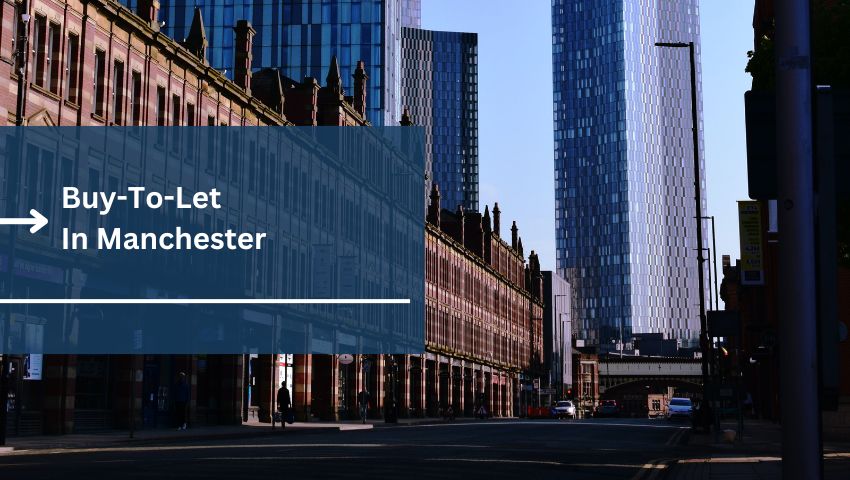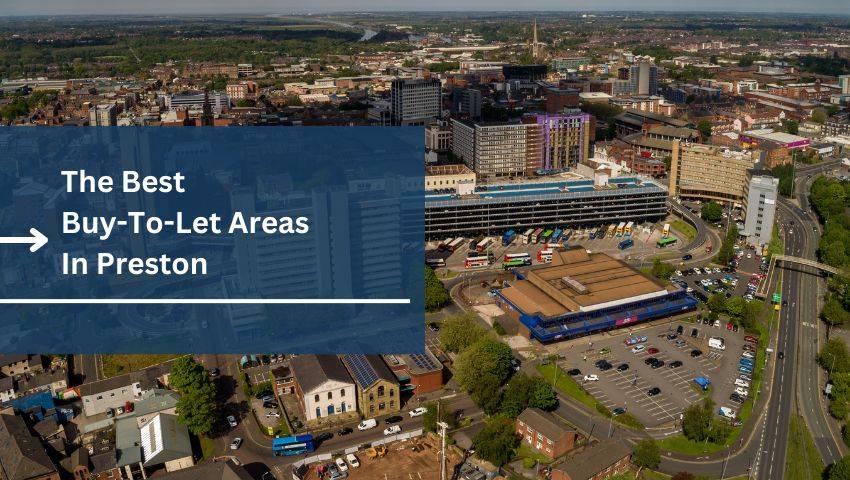Manchester is one of the most exciting cities in the UK for buy-to-let property investment. It’s easy to see why: a growing population of young professionals, three prestigious universities, consistent growth in property and rental values, vast investment and regeneration, and a thriving tech sector. The list goes on.
Plus, there are a growing number of buy-to-let properties available at prices to suit the budgets of all investors. New developments are spread over several areas, such as Media City, Salford, Ancoats and the student-friendly districts near Oxford Road.
This last point, in particular, is a major reason why many investors have turned their attention towards Manchester. London was once the go-to property investment location in the UK, but the average price of a property in the capital is now out of reach for many. It has led to tighter rental yields too.
Meanwhile, Manchester has emerged as the new hotspot. In 2020, Aldermore’s Buy To Let City Tracker named Manchester as the top city in the UK. It looked at factors such as average rental prices, yields, capital appreciation, occupancy, and the size of the city’s population in the rental market.
Meanwhile, Savill’s 2021 Regional Forecasts put the North West at the top of the table for their five-year house price estimates. Savill’s expect an 18.8% growth in values over the next five years.
TimeOut’s survey of 27,000 city-dwellers even ranked Manchester as the third-best city in the world – just behind San Francisco and Amsterdam.
And our own simple research found interest in Manchester is soaring: since January 2018, the number of people who search Google for “property investment Manchester” has grown by 122.2% (from 720 searches to 1,600). By comparison, searches for London have grown by just 90%. And North West rival, Liverpool, is only up 70%.
As a property investment company, we’ve seen this trend in action over the past few years. And we’ve advised our clients to look northwards, helping them to find the best buy-to-let projects in the region. So, in this guide, we’ll share what we know and make a case for buy-to-let in Manchester.
Contents
- Why Buy To Let?
- Why Manchester?
- Market Forecast
- Compared To Liverpool
- Student Market
- The Best Areas For Buy-To-Let In Manchester
- What Type of Buy-to-Let in Manchester?
- How Much Will I Need?
- Summary
Why Buy-To-Let?
A buy-to-let property is any property purchased with the intention of letting it out. This can be through a short-term-letting model (e.g. Airbnb) or as part of a long-term, traditional tenancy agreement.
There are, of course, other property investment strategies, but we’re huge advocates of buy-to-let. Here’s why:
- Monthly rental income should cover all costs, whilst still providing a profit for the owner
- Long-term, properties increase in value (even accounting for temporary dips, like a global recession or a pandemic), meaning owners can benefit from huge capital appreciation
- Buyers can usually leverage their purchase with finance, requiring a much lower initial investment
- Modern buy-to-let projects have property management companies in place, allowing for a hands-off investment
- There’s a wide resale market as a proven, high-performing buy-to-let will always attract interest from other investors (along with those looking to purchase their own home)
Why Manchester?
There are four clear reasons to purchase a buy-to-let in Manchester:
- Rental prices are growing
- Rental yield performance suggests clear profitability in the market
- Property values are growing
- It’s a desirable place to live, work and visit
We’ll explore each of these factors in more detail below.
Rental Value Growth
Boosted by higher demand than ever, the average rental price in the northwest has increased on average 6.3% yearly, up over 12% since April 2019. Being one of the most economically productive and culturally significant cities in the UK, Manchester is in the ideal position to capitalise on this growth.
Real estate consultancy company, JLL, forecast an estimated increase in Manchester’s rental value of 12.5% by 2025. This substantially outperforms the UK average and suggests a quick recovery from the effects of Covid.
Rental Yields
Rental yields are a strong indication of the strength of an investment and the desirability of an area for people looking to rent properties. They are calculated by dividing the total rental income over 12 months by the property’s total value, resulting in a percentage. Obviously the higher this number, the more profitable the investment. To learn more about rental yields, read our guide.
Manchester’s rental yields are usually among the best in the UK, far outperforming London and southern England. This is bolstered by reasonable property prices and an influx of young professionals and students, creating a constant demand for rental accommodation. These factors often see Manchester named the best city in the UK for buy-to-let investors.
Capital Appreciation
Property values all across Greater Manchester have shown excellent growth in recent years. Data from the HM Land Registry shows the average property price has increased by 40% since 2015.
This is another string in Manchester’s bow. Property value growth (also referred to as capital appreciation) can net buyers huge returns on their investments.
And more is predicted too. JLL predict Manchester’s property values will increase by an average of 18.5% by 2025.
A Leading, Modern City
Simply put, Manchester is a city that people want to live in. TimeOut even named it the best city in the UK, and third-best in the world.
The UK’s second city is an equal match for London, with a booming job market, top transport links, world-class bars and restaurants, high-quality property, vast regeneration schemes, and rich history in music, sport and culture. Yet, the cost of living is up to 30% lower, with property, in particular, proving to be far more affordable.
Its status as a leading light attracts tourists too. The visitor economy is worth over £7.5bn annually, with Manchester the third most visited city in the UK after London and Edinburgh.
All of this should be welcome news to a buy-to-let investor. A desirable city will further contribute to the demand for rental property and boost property values.
Market Forecast
Almost every study of the Manchester property market forecasts major growth in the city and the surrounding region. Here are the highlights:
- Savills estimate property values will grow by 18.8% over the next five years in the North West, the best of any region in the UK
- JLL predict rental values will grow by an average of 2.9% per annum, above the national average
- The GMCA suggest GVA is set to grow in Greater Manchester by 2.3% per annum, adding an extra £37bn into the local economy by 2036
- Greater Manchester’s population is growing quicker than the national standard, with the ONS predicting a further 10% growth over the next 20 years (300,000 more people)
To learn more, read our Manchester property forecast.
Compared To Liverpool
Separated by a mere 34 miles along the M62, Manchester and Liverpool have long been fierce rivals. In sports, football clubs from both cities have battled away for decades. In music, one gave the world Oasis, The Smiths and The Stone Roses, the other gave us arguably the most famous and successful band ever, The Beatles.
The two often compete in other fields too. Property is one. The truth is that the property markets in both cities have incredible potential and offer huge amounts of value for buy-to-let investors.
In a recent post, we compared whether it was better to invest in Manchester or Liverpool.
Based on the available data and our own expertise, Manchester and Liverpool represent the two best cities in the UK for property investment. Historically, they’ve suffered from economic downturns, but the outlook could not be any more different today.
Huge investment has stimulated a rapid improvement in both city’s fortunes since the 1990s. The introduction of the “Northern Powerhouse” in 2014 boosted growth and private investment is now pouring in by the millions.
So, it’s hard to split the two. One argument could be that whilst Manchester is predicted to offer better growth in rental values and property prices over the next few years, Liverpool is slightly more affordable as it stands (and the forecasted difference is only small).
Some investors will prefer the lower entry price of Liverpool, whilst others may want to benefit from the stronger growth of Manchester. At the end of the day, you really can’t go wrong with either.
For more on Liverpool, read our guide: Where Are The Best Buy-To-Let Areas In Liverpool?
Student Market
Greater Manchester has two major universities: The University of Manchester and Manchester Metropolitan University. There are also several other educational institutions, such as the highly-regarded Royal Northern College of Music and The University of Salford.
Overall, there are approximately 100,000 students in the city at any one time. And there’s an impressive graduate retention rate of 51% (the second-highest in the country after London).
International students form approximately 20% of the University population. They’re attracted by the internationally renowned level of education provided by the city’s educational institutes. The University of Manchester, for example, is a Russell Group member and ranks in the top 100 universities globally. Alumni and professors of the University have contributed significant developments to the fields of physics, computing, biology, engineering, and more. This prestigious status attracts students from all over the world.
And where students go, business follows. Manchester’s conveyor belt of top talent has influenced companies such as Amazon, Google, Microsoft, Booking.com, and others, to set up offices in the area. The BBC and ITV call Salford’s MediaCity home. And several Manchester-born companies have flourished in recent years, including Boohoo, AO, and AutoTrader. This creates a thriving job market and contributes to the exceptional graduate retention rate mentioned above.
For more about Manchester’s student market, read our guide: The Best Areas For Student Property Investment In Manchester
Why Is This Good For Investors?
The vast, growing student population means a consistent demand for varying types of student property to suit all budgets. This includes houses and city centre apartments to purpose-built accommodation on or near campus.
Plus, with so many graduates choosing to stick around or come back (around 57% of students who leave Manchester to study elsewhere return after graduation), there’s a constant influx of talented young professionals into the city’s rental market.
Manchester’s buy-to-let investors stand to benefit from both groups. Student property usually attracts exceptional yields, either from renting to multiple occupants in a Student HMO or from well-funded students paying higher prices for better quality, purpose-built accommodation. Meanwhile, well-finished city-centre apartments appeal to the young professionals who stick around. Such apartments achieve excellent returns for investors through solid yields and capital appreciation.
If you’d like to learn more, read our guide to student property investment.
The Best Areas For Buy-To-Let In Manchester
It’s clear Manchester is an excellent choice of location for any property investor. So, with that in mind, where are the best places in the city for investors to consider and research?
To answer that question, we’ve completed our own research using two pieces of market data: average rental yields and capital appreciation. Rental yields will help us understand the scale of return an investor can expect from a buy-to-let property, whilst capital appreciation will show the long-term value of holding a property.
Greater Manchester consists of ten metropolitan boroughs: Bolton, Bury, Oldham, Rochdale, Stockport, Tameside, Trafford, Wigan, Manchester and Salford (these final two have ‘city’ status). Across each borough, there are 82 postcode districts (e.g. BL1 in Bolton, M5 in Salford, and so on). We’ve accounted for all of them in our research.
The results are below…
Top 25 Areas In Greater Manchester For Buy-To-Let, By Rental Yield
| Postcode | Borough | Avg Asking Rent (pm) | Avg Yield |
|---|---|---|---|
| M14 | Manchester | £1,680.00 | 9.60% |
| M13 | Manchester | £1,356.00 | 7.20% |
| M6 | Salford | £1,081.00 | 6.60% |
| M9 | Manchester | £858.00 | 6.30% |
| M5 | Salford | £1,040.00 | 6.20% |
| M3 | Manchester | £1,055.00 | 5.90% |
| M11 | Manchester | £841.00 | 5.90% |
| M19 | Manchester | £1,226.00 | 5.90% |
| M50 | Salford | £987.00 | 5.70% |
| M1 | Manchester | £1,063.00 | 5.40% |
| M7 | Salford | £920.00 | 5.30% |
| M4 | Manchester | £1,042.00 | 5.20% |
| M15 | Manchester | £1,215.00 | 5.20% |
| M24 | Rochdale | £762.00 | 5.10% |
| M40 | Manchester | £787.00 | 5.10% |
| WN7 | Wigan | £636.00 | 5.10% |
| M22 | Manchester | £865.00 | 5.00% |
| M46 | Wigan | £668.00 | 5.00% |
| OL16 | Rochdale | £762.00 | 5.00% |
| SK5 | Stockport | £828.00 | 5.00% |
| BL3 | Bolton | £671.00 | 4.90% |
| M23 | Manchester | £928.00 | 4.90% |
| M30 | Salford | £800.00 | 4.90% |
| WN2 | Wigan | £598.00 | 4.90% |
| M27 | Salford | £864.00 | 4.80% |
| M43 | Tameside | £760.00 | 4.80% |
This table shows where the highest rental yields, a cornerstone of any buy-to-let investment, can be achieved across Greater Manchester.
Whilst many would have expected the city centre to dominate, that’s not necessarily the case. Although it does very well with M1 (Gay Village, Northern Quarter & Piccadilly), M3 (Deansgate, Green Quarter & Spinningfields) and M4 (Ancoats, New Islington, NOMA & Northern Quarter) all ranking in the top half of the table, it is M14 which, by some distance, offers the best rental yields in the city.
M14 is home to much of Manchester’s university population, containing the student-house-dominated Fallowfield and extending towards the city centre via Rusholme’s famous Curry Mile. Student accommodation is known for consistently generating exceptional yields.
Neighbouring postcode, M13, also performs well for similar reasons. Starting in Longsight, the postcode stretches all the way up to the very edge of the city centre, covering Ardwick, Manchester Royal Infirmary, the University of Manchester campus, and much of the popular Oxford Road. Once again, this is a student-heavy area, so it’s no surprise to find stronger-than-average yields.
We should point out Salford too. With five postcodes in the top 25, it’s the second-best performing borough in the metropolitan region after Manchester. The borough’s ongoing regeneration is stimulating an increase in rental prices and, with it, yields. Plus, as we’ll see in the next section, property values are climbing quickly too. Hotspots with large volumes of new apartment blocks aimed at young professionals, such as Blackfriars (M3), Ordsall (M5) and MediaCity (M50), are major drivers.
Top 25 Postcodes In Greater Manchester By Property Value Growth
| Postcode | Borough | Avg Asking Price | 5 Year Growth |
|---|---|---|---|
| M38 | Salford | £142,691.00 | 67.00% |
| M16 | Trafford | £224,988.00 | 63.00% |
| M18 | Manchester | £161,770.00 | 60.00% |
| M19 | Manchester | £249,302.00 | 58.00% |
| M31 | Trafford | £225,879.00 | 54.00% |
| SK16 | Tameside | £203,435.00 | 54.00% |
| M23 | Manchester | £226,050.00 | 52.00% |
| M9 | Manchester | £163,391.00 | 51.00% |
| M24 | Rochdale | £178,649.00 | 51.00% |
| M40 | Manchester | £184,578.00 | 51.00% |
| M7 | Salford | £209,720.00 | 50.00% |
| M4 | Manchester | £241,934.00 | 49.00% |
| M27 | Salford | £214,612.00 | 49.00% |
| OL7 | Tameside | £179,280.00 | 47.00% |
| OL9 | Oldham | £194,547.00 | 46.00% |
| BL4 | Bolton | £156,780.00 | 46.00% |
| M32 | Trafford | £271,641.00 | 46.00% |
| OL1 | Oldham | £164,427.00 | 44.00% |
| M5 | Salford | £201,042.00 | 44.00% |
| M30 | Salford | £195,491.00 | 44.00% |
| SK5 | Stockport | £198,586.00 | 43.00% |
| M35 | Oldham | £192,753.00 | 42.00% |
| M6 | Salford | £197,451.00 | 42.00% |
| M43 | Tameside | £189,710.00 | 42.00% |
| M45 | Bury | £255,258.00 | 42.00% |
| M8 | Manchester | £188,949.00 | 41.00% |
This table shows the areas of the city that have seen the highest growth in property values over the past five years.
We find that areas outside the city centre perform best, which is no surprise.
Naturally, properties in the centre are already some of the most expensive in the region. And whilst they have grown considerably in the past five years, they do not have the same potential for growth as a lower-value area.
For example, average asking prices in M4 (Ancoats, New Islington, NOMA & Northern Quarter) have grown by 49%, from £162,372 to £241,934 – a raw increase of £79,562.
Meanwhile, average asking prices in M38 (Little Hulton), which is roughly 10 miles from the city centre, have shot up by 67%. But prices were lower to begin with, so the raw increase in value is lower than M4 at just £57,247.
This is why we see the top 25 peppered with postcodes from a more diverse range of boroughs. The whole of the Greater Manchester region is witnessing strong growth in house prices, but it’s the areas with the lowest values that will net the highest percentage increases. This doesn’t necessarily mean these postcodes are good choices for buy-to-let investors.
An investor stands to benefit far more from the higher raw increase in value in more central postcodes, especially after factoring in the rental market.
Nonetheless, within the top five, there are several locations considered up-and-coming. M16, M18, and M19 are all fairly close to the centre and have excellent transport links. Their growth may even result from homebuyers being valued out of neighbouring, in-demand locations.
M16, covering a large section of Trafford, sits just north of the leafy Chorlton (M21), where the average asking price is £349,620. Buyers not able to afford such prices may be looking towards Trafford as a “next best” choice, given its accessibility to both Chorlton and the city centre.
It may be a similar story for M18 (Levenshulme) and M19 (Gorton). Both are in close proximity to West Didsbury (M20, average value of £327,909) and Stockport’s highly sought-after “Four Heatons”. Heaton Chapel and Heaton Mersey, Heaton Moor and Heaton Norris all sit in SK4, where asking prices average £322,615.
Levenshulme was, in fact, named one of the best places to live by The Sunday Times, no doubt contributing to further demand for the area.
Buy-to-let investors may wish to pay attention to this trend. If these areas are attracting buyers, the likelihood is they’ll attract renters too – especially with ongoing regeneration schemes and the fact they’re within easy reach of the city centre.
So, where are the best buy-to-let areas in Manchester?
We believe the best buy-to-let properties offer a well-balanced mix of rental yields and capital appreciation.
A strong rental yield covers the cost of owning a property whilst building equity and boosting an investor’s monthly income. Meanwhile, capital appreciation offers a substantial pay-out in the future, when the time comes to sell.
So, with that in mind, we wanted to combine the two data points above to identify the best buy-to-let locations in Manchester.
We’ve used a simple system. There are 82 postcode districts in the region. The postcode with the highest rental yield receives 82 points. The second-best receives 81 points. And so on.
The same is applied to the growth in values. The postcode with the highest growth in value receives 82 points. The second-best receives 81 points. And so on.
We then weighted the scores. Rental yield scores were multiplied by two, whilst capital appreciation scores were not. This places emphasis on yield, which takes slight precedence for buy-to-let investors.
Then, the points have been added together to calculate a final score, by which the results are ordered. Here are the results:
| Postcode | Borough | Avg Yield | Yield Score | Avg Asking Price | 5 Year Growth | Growth Score | Combined Score |
|---|---|---|---|---|---|---|---|
| M9 | Manchester | 6.30% | 158.00 | £163,391.00 | 51.00% | 75.00 | 233.00 |
| M19 | Manchester | 5.90% | 154.00 | £249,302.00 | 58.00% | 79.00 | 233.00 |
| M5 | Salford | 6.20% | 156.00 | £201,042.00 | 44.00% | 63.00 | 219.00 |
| M6 | Salford | 6.60% | 160.00 | £197,451.00 | 42.00% | 58.00 | 218.00 |
| M7 | Salford | 5.30% | 144.00 | £209,720.00 | 50.00% | 72.00 | 216.00 |
| M4 | Manchester | 5.20% | 142.00 | £241,934.00 | 49.00% | 71.00 | 213.00 |
| M24 | Rochdale | 5.10% | 138.00 | £178,649.00 | 51.00% | 75.00 | 213.00 |
| M40 | Manchester | 5.10% | 138.00 | £184,578.00 | 51.00% | 75.00 | 213.00 |
| M13 | Manchester | 7.20% | 162.00 | £225,147.00 | 34.00% | 39.00 | 201.00 |
| M50 | Salford | 5.70% | 148.00 | £206,852.00 | 37.00% | 52.00 | 200.00 |
| M23 | Manchester | 4.90% | 124.00 | £226,050.00 | 52.00% | 76.00 | 200.00 |
| M14 | Manchester | 9.60% | 164.00 | £209,907.00 | 32.00% | 33.00 | 197.00 |
| SK5 | Stockport | 5.00% | 132.00 | £198,586.00 | 43.00% | 62.00 | 194.00 |
| M30 | Salford | 4.90% | 124.00 | £195,491.00 | 44.00% | 63.00 | 187.00 |
| M27 | Salford | 4.80% | 116.00 | £214,612.00 | 49.00% | 71.00 | 187.00 |
| M16 | Trafford | 4.50% | 104.00 | £224,988.00 | 63.00% | 81.00 | 185.00 |
| M11 | Manchester | 5.90% | 154.00 | £170,055.00 | 30.00% | 29.00 | 183.00 |
| BL3 | Bolton | 4.90% | 124.00 | £162,920.00 | 37.00% | 52.00 | 176.00 |
| M43 | Tameside | 4.80% | 116.00 | £189,710.00 | 42.00% | 58.00 | 174.00 |
| BL4 | Bolton | 4.60% | 108.00 | £156,780.00 | 46.00% | 66.00 | 174.00 |
| M22 | Manchester | 5.00% | 132.00 | £205,698.00 | 33.00% | 37.00 | 169.00 |
| OL10 | Rochdale | 4.80% | 116.00 | £175,963.00 | 35.00% | 47.00 | 163.00 |
| M3 | Manchester | 5.90% | 154.00 | £213,757.00 | 12.00% | 3.00 | 157.00 |
| SK1 | Stockport | 4.70% | 110.00 | £183,952.00 | 35.00% | 47.00 | 157.00 |
| M20 | Manchester | 4.60% | 108.00 | £327,909.00 | 35.00% | 47.00 | 155.00 |
| M15 | Manchester | 5.20% | 142.00 | £281,090.00 | 19.00% | 7.00 | 149.00 |
| M1 | Manchester | 5.40% | 146.00 | £237,016.00 | 7.00% | 2.00 | 148.00 |
| WN7 | Wigan | 5.10% | 138.00 | £150,388.00 | 22.00% | 10.00 | 148.00 |
| SK3 | Stockport | 4.30% | 92.00 | £224,751.00 | 41.00% | 56.00 | 148.00 |
| M32 | Trafford | 4.10% | 82.00 | £271,641.00 | 46.00% | 66.00 | 148.00 |
The best buy-to-let postcodes in Greater Manchester are primarily within Manchester and Salford, with only a few interjections by the other boroughs.
Salford does particularly well, with three postcodes in the top five. Residential projects in the previously mentioned MediaCity, Ordsall and Blackfriars have attracted a lot of investor interest over the last few years and will continue to do so.
However, it’s Manchester’s M9 that comes out on top. This is an interesting result considering M9 covers Blackley and Hapurhey, an area named as the most deprived in the UK in 2007. Yet it clearly offers immediate returns with long-term potential for landlords, as values are still quite low but yields are strong. These areas are starting to attract investment, too, with regeneration now radiating outwards from the city centre (the Northern Gateway is a £1billion scheme, for example).
In summary, there is value to be found all over Greater Manchester for a buy-to-let investor. Aside from the popular, well-known areas across the centre, this research has sprung a number of surprises that highlight the value of looking around.
What Type of Buy-to-Let in Manchester?
The type of buy-to-let property in Manchester to go after really depends on your budget and aims, so we’ll review a few options in this section.
Student Houses and/or HMOs
A house in multiple occupation (HMO) is a property where several tenants (usually at least 3) co-reside and have separate tenancy agreements with the landlord.
This type of property naturally includes student housing. As such, you’ll find plenty of HMOs in Manchester’s student-heavy areas, like Fallowfield, Hulme, Rusholme, Withington and along Oxford Road. There are non-student HMOs available all across the region, too.
Whilst an HMO buy-to-let in Manchester tends to generate a good yield, it will usually require a hands-on landlord to maintain and manage the property. Tenant turnover is usually much higher, although it’s rarer to have an entirely empty house so void periods are softened.
Plus, it’s worth keeping in mind that many students are now opting for purpose-built student accommodation (PBSA) over the traditional house share. PBSA is generally much higher quality and offers on-site amenities, like gyms, private parking, and communal rooms. They’re a student version of the all-in-one, city-centre residential blocks that have become incredibly popular for young professionals.
PBSA
PBSA, or ‘purpose-built student accommodation’, are apartment blocks built to provide higher-quality student flats for either individual students or groups.
Manchester City Council has recognised an undersupply of PBSA in the city and wants to increase the number of PBSA units available over the coming years. These will likely come along Oxford Road and into the city centre.
As with any student housing, PBSA is generally cheaper than a typical residential property, yet offers consistently high yields. The downside is that property values tend to not grow as quickly.
City-Centre Apartments
In the past 10 years, Manchester’s skyline has changed dramatically. The Beetham Tower in Castlefield once stood alone as the tallest building in the city. It now has two residential blocks at Deansgate Square for company, with the South Tower taking the mantle as the tallest (and in fact, the tallest building in the UK outside London).
New blocks have been erected at a frightening pace. Nearly 50% of the buildings over 50m in Manchester have been built since 2010. Many have been in the city centre to house young professionals.
The performance of these blocks is fantastic. Young professionals are willing to pay good prices for high-quality apartment blocks in central locations, so yields are strong. Meanwhile, the value of such properties grows quickly.
We tend to recommend this type of property most often to our clients. There are two options: properties that are already complete, or properties in construction (which we refer to as “off-plan”).
We think there’s a tremendous amount of value to be had in off-plan property, especially for buy-to-let in Manchester where there are a number of impressive projects in the pipeline. You can learn more about off-plan property here.
How Much Will I Need?
The budget required to get started with buy-to-let in Manchester will depend on the property you’re after.
Our suggestion is to set aside a minimum of £50,000. This is a reasonable starting sum that most first-time investors have available. With £50,000, cities like Manchester are excellent choices as property values are still low enough that your budget can cover a deposit on a city-centre apartment. A mortgage will cover the rest.
We’ve discussed how to invest £50k in property previously. You can invest in property without vast amounts of capital, especially if you target off-plan properties.
However, £50,000 may not be enough if you’re looking to invest in one of Manchester’s student properties. Although values are lower, PBSA cannot be bought with a mortgage and must be paid in full by cash.
Summary
By this point, the reasons to invest in a buy-to-let in Manchester, and the long-term benefits of doing so, should be clear.
We consider it to be the best city in the UK (along with Liverpool) for buy-to-let investment. And that’s why we review all of the latest projects within the city to find suitable investment opportunities for our clients.
If you’re interested in learning more or finding a property, please get in touch and one of our team would be more than happy to run through your options.
We’ll support you through every stage of your investment journey, from finding a property to providing after-sales construction updates. We don’t charge any fees for our service and we’re part of the Property Ombudsman, an organisation designed to protect investors.






































